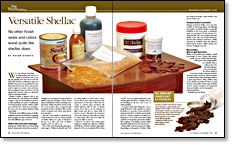All About Shellac

For good reason, woodworkers have been using shellac for fine furniture projects for hundreds of years. It is prized for the deep, rich color that its resins give to wood surfaces and for its ease of application.
The Basics:
• Apply it by brush, wiping rag, or spray gun
• Quick drying
• Adheres extremely well to other finishes, as well as to raw wood
Shellac is often used as a sealer coat and as a barrier coat between other finishes, such as oil and varnish, or when refinishing antique furniture. Over itself, each coat of shellac melts into and bonds with any previous coats.
The resins that makeup the protective layer of film formed when shellac dries are derived from the secretions of Laccifer lacca bugs, which are indigenous to Southeast Asia. The female lac bugs exude a mixture of the resins and wax as they form protective cocoons to protect their eggs. After the newly hatched bugs have matured and flown the coop, the spent shell casings are collected and refined to make the many grades of shellac that are available to woodworkers: seed lac, button lac, garnet, orange, and blond. Each stage of the refinement process produces dried flakes of different colors that are then mixed with denatured alcohol to make a usable finish to apply on furniture.
All shellac naturally contains wax, and the wax can cause adhesion problems if other finishes are applied over it. So if you apply wax as a sealer or a barrier coat, you’re better off using the dewaxed variety. When you buy premixed shellac in a can, it will clearly be indicated on the label if the manufacturer has already removed the wax. If you mix your own shellac from flakes, it’s easy to dewax the mixture yourself. Once the flakes are thoroughly dissolved in the alcohol, let it rest on the shelf for a couple of days, and the heavier wax will settle to the bottom of the jar. At that point, you can pour off the mixture from the top of the jar, leaving the wax residue behind.
Shellac has a limited shelf life — several months to a couple of years, depending upon storage conditions — and freshly mixed solutions offer a better moisture resistance than those that have sat on the shelf for a long time. For that reason, you’re better off mixing your own. The proportion of flakes to alcohol in the mixture (traditionally described as “pound-cuts,” meaning the number of pounds of flakes added to one gallon of alcohol) will affect the viscosity of the solution and therefore the ease with which it goes on. If you’re mixing shellac for the first time, you don’t have to be so precise or use a scale to make a batch. Experience will soon give you an intuitive feel for the right proportions of flakes to alcohol, and how you plan to apply it will affect the ideal viscosity you want. I like mine to be not as thin as water and not as thick as heavy cream.
A solution of warm water and household ammonia works well to clean up brushes and spray equipment, but be sure to use a final rinse of plain water to get rid of any ammonia residue. If you devote one good bristle brush to use with shellac, you don’t really eve have to clean the brush. Just let it dry with the shellac still on the bristles, and then soak it for an hour in denatured alcohol before you want to use it next.
One other interesting tidbit: Dried shellac is completely non-toxic, so it’s a good finish to use on children’s toys or furniture. As a matter of fact, candy manufacturers and pharmaceutical companies use shellac coatings to maintain the freshness of their edible products.
Fine Woodworking Recommended Products


Bahco 6-Inch Card Scraper

Diablo ‘SandNet’ Sanding Discs






















Log in or create an account to post a comment.
Sign up Log in